Furao Shen
School of Artificial Intelligence, Nanjing University
RL-Selector: Reinforcement Learning-Guided Data Selection via Redundancy Assessment
Jun 26, 2025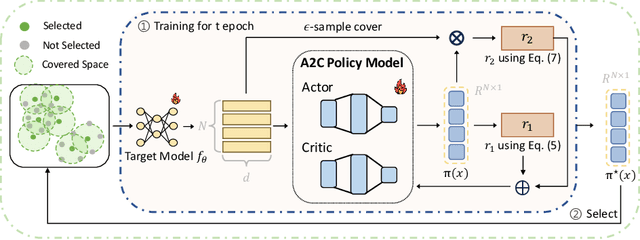
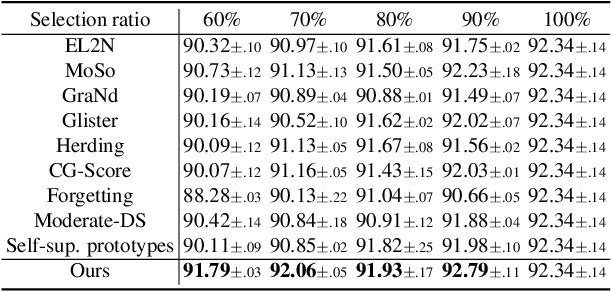
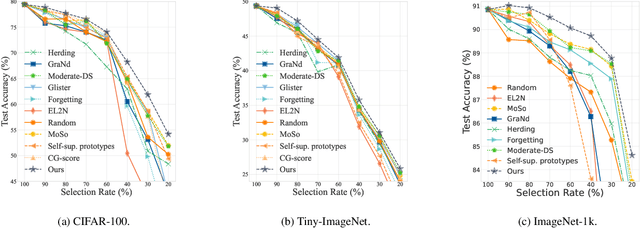

Abstract:Modern deep architectures often rely on large-scale datasets, but training on these datasets incurs high computational and storage overhead. Real-world datasets often contain substantial redundancies, prompting the need for more data-efficient training paradigms. Data selection has shown promise to mitigate redundancy by identifying the most representative samples, thereby reducing training costs without compromising performance. Existing methods typically rely on static scoring metrics or pretrained models, overlooking the combined effect of selected samples and their evolving dynamics during training. We introduce the concept of epsilon-sample cover, which quantifies sample redundancy based on inter-sample relationships, capturing the intrinsic structure of the dataset. Based on this, we reformulate data selection as a reinforcement learning (RL) process and propose RL-Selector, where a lightweight RL agent optimizes the selection policy by leveraging epsilon-sample cover derived from evolving dataset distribution as a reward signal. Extensive experiments across benchmark datasets and diverse architectures demonstrate that our method consistently outperforms existing state-of-the-art baselines. Models trained with our selected datasets show enhanced generalization performance with improved training efficiency.
* ICCV 2025
SPAT: Sensitivity-based Multihead-attention Pruning on Time Series Forecasting Models
May 13, 2025Abstract:Attention-based architectures have achieved superior performance in multivariate time series forecasting but are computationally expensive. Techniques such as patching and adaptive masking have been developed to reduce their sizes and latencies. In this work, we propose a structured pruning method, SPAT ($\textbf{S}$ensitivity $\textbf{P}$runer for $\textbf{At}$tention), which selectively removes redundant attention mechanisms and yields highly effective models. Different from previous approaches, SPAT aims to remove the entire attention module, which reduces the risk of overfitting and enables speed-up without demanding specialized hardware. We propose a dynamic sensitivity metric, $\textbf{S}$ensitivity $\textbf{E}$nhanced $\textbf{N}$ormalized $\textbf{D}$ispersion (SEND) that measures the importance of each attention module during the pre-training phase. Experiments on multivariate datasets demonstrate that SPAT-pruned models achieve reductions of 2.842% in MSE, 1.996% in MAE, and 35.274% in FLOPs. Furthermore, SPAT-pruned models outperform existing lightweight, Mamba-based and LLM-based SOTA methods in both standard and zero-shot inference, highlighting the importance of retaining only the most effective attention mechanisms. We have made our code publicly available https://anonymous.4open.science/r/SPAT-6042.
Interactive Instance Annotation with Siamese Networks
May 06, 2025Abstract:Annotating instance masks is time-consuming and labor-intensive. A promising solution is to predict contours using a deep learning model and then allow users to refine them. However, most existing methods focus on in-domain scenarios, limiting their effectiveness for cross-domain annotation tasks. In this paper, we propose SiamAnno, a framework inspired by the use of Siamese networks in object tracking. SiamAnno leverages one-shot learning to annotate previously unseen objects by taking a bounding box as input and predicting object boundaries, which can then be adjusted by annotators. Trained on one dataset and tested on another without fine-tuning, SiamAnno achieves state-of-the-art (SOTA) performance across multiple datasets, demonstrating its ability to handle domain and environment shifts in cross-domain tasks. We also provide more comprehensive results compared to previous work, establishing a strong baseline for future research. To our knowledge, SiamAnno is the first model to explore Siamese architecture for instance annotation.
Physics-inspired Energy Transition Neural Network for Sequence Learning
May 06, 2025Abstract:Recently, the superior performance of Transformers has made them a more robust and scalable solution for sequence modeling than traditional recurrent neural networks (RNNs). However, the effectiveness of Transformer in capturing long-term dependencies is primarily attributed to their comprehensive pair-modeling process rather than inherent inductive biases toward sequence semantics. In this study, we explore the capabilities of pure RNNs and reassess their long-term learning mechanisms. Inspired by the physics energy transition models that track energy changes over time, we propose a effective recurrent structure called the``Physics-inspired Energy Transition Neural Network" (PETNN). We demonstrate that PETNN's memory mechanism effectively stores information over long-term dependencies. Experimental results indicate that PETNN outperforms transformer-based methods across various sequence tasks. Furthermore, owing to its recurrent nature, PETNN exhibits significantly lower complexity. Our study presents an optimal foundational recurrent architecture and highlights the potential for developing effective recurrent neural networks in fields currently dominated by Transformer.
When Dynamic Data Selection Meets Data Augmentation
May 02, 2025
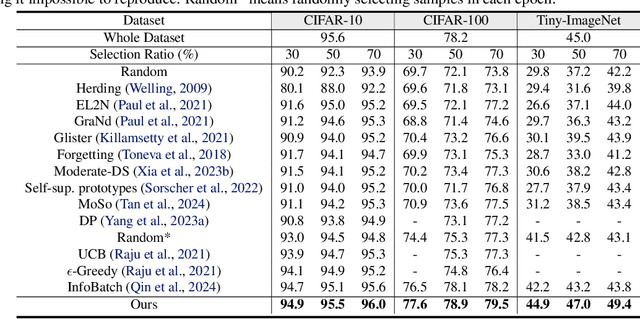

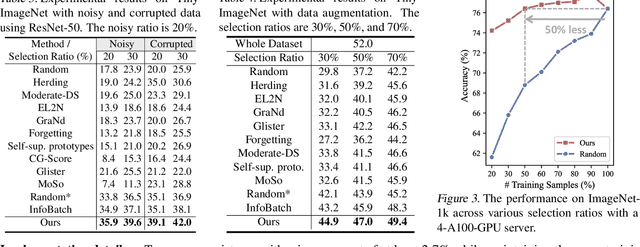
Abstract:Dynamic data selection aims to accelerate training with lossless performance. However, reducing training data inherently limits data diversity, potentially hindering generalization. While data augmentation is widely used to enhance diversity, it is typically not optimized in conjunction with selection. As a result, directly combining these techniques fails to fully exploit their synergies. To tackle the challenge, we propose a novel online data training framework that, for the first time, unifies dynamic data selection and augmentation, achieving both training efficiency and enhanced performance. Our method estimates each sample's joint distribution of local density and multimodal semantic consistency, allowing for the targeted selection of augmentation-suitable samples while suppressing the inclusion of noisy or ambiguous data. This enables a more significant reduction in dataset size without sacrificing model generalization. Experimental results demonstrate that our method outperforms existing state-of-the-art approaches on various benchmark datasets and architectures, e.g., reducing 50\% training costs on ImageNet-1k with lossless performance. Furthermore, our approach enhances noise resistance and improves model robustness, reinforcing its practical utility in real-world scenarios.
Explaining Model Overfitting in CNNs via GMM Clustering
Dec 12, 2024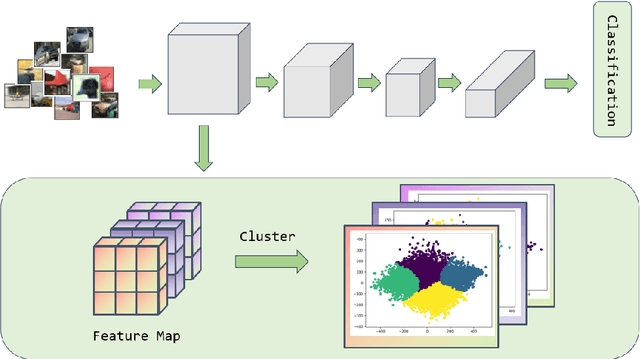

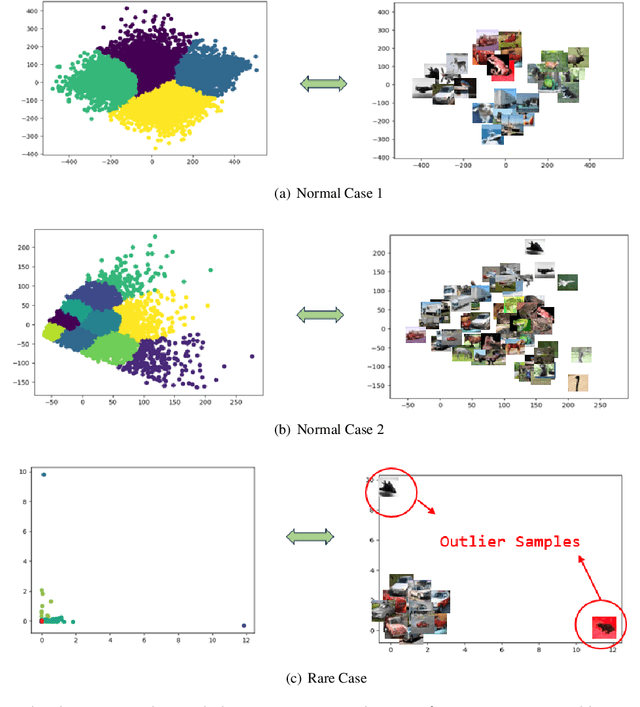

Abstract:Convolutional Neural Networks (CNNs) have demonstrated remarkable prowess in the field of computer vision. However, their opaque decision-making processes pose significant challenges for practical applications. In this study, we provide quantitative metrics for assessing CNN filters by clustering the feature maps corresponding to individual filters in the model via Gaussian Mixture Model (GMM). By analyzing the clustering results, we screen out some anomaly filters associated with outlier samples. We further analyze the relationship between the anomaly filters and model overfitting, proposing three hypotheses. This method is universally applicable across diverse CNN architectures without modifications, as evidenced by its successful application to models like AlexNet and LeNet-5. We present three meticulously designed experiments demonstrating our hypotheses from the perspectives of model behavior, dataset characteristics, and filter impacts. Through this work, we offer a novel perspective for evaluating the CNN performance and gain new insights into the operational behavior of model overfitting.
Estimating the treatment effect over time under general interference through deep learner integrated TMLE
Dec 06, 2024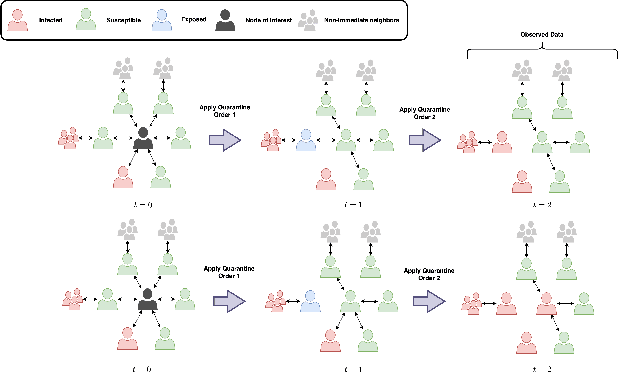
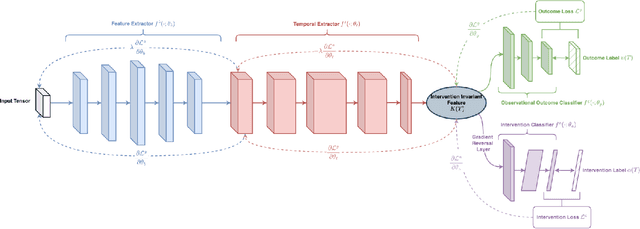
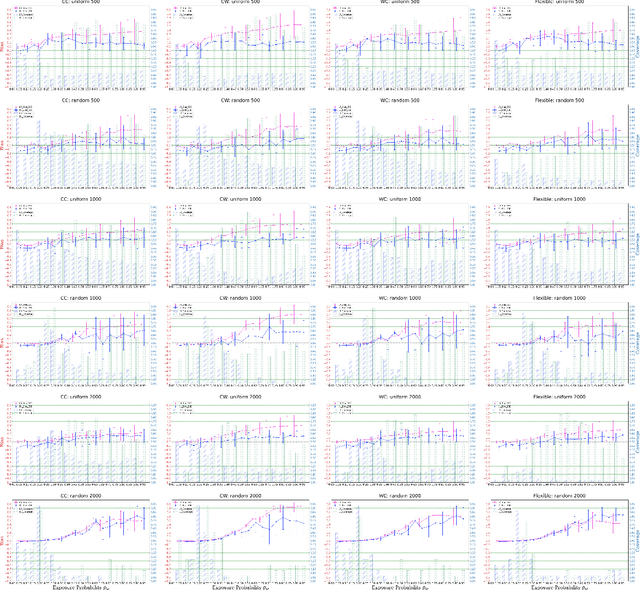
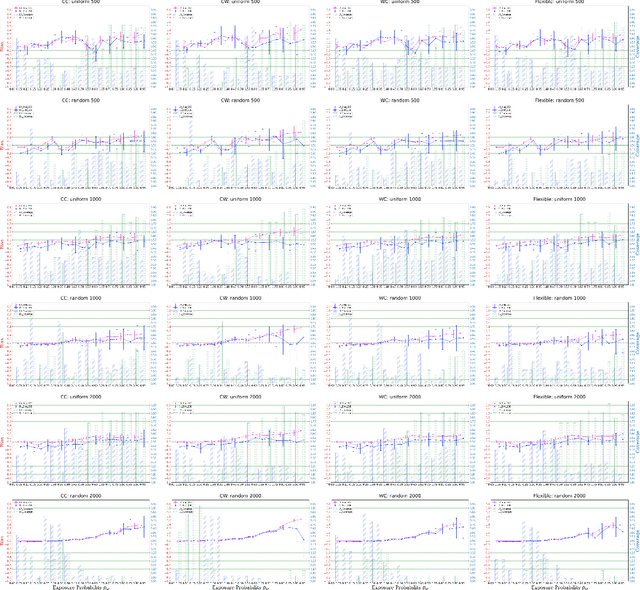
Abstract:Understanding the effects of quarantine policies in populations with underlying social networks is crucial for public health, yet most causal inference methods fail here due to their assumption of independent individuals. We introduce DeepNetTMLE, a deep-learning-enhanced Targeted Maximum Likelihood Estimation (TMLE) method designed to estimate time-sensitive treatment effects in observational data. DeepNetTMLE mitigates bias from time-varying confounders under general interference by incorporating a temporal module and domain adversarial training to build intervention-invariant representations. This process removes associations between current treatments and historical variables, while the targeting step maintains the bias-variance trade-off, enhancing the reliability of counterfactual predictions. Using simulations of a ``Susceptible-Infected-Recovered'' model with varied quarantine coverages, we show that DeepNetTMLE achieves lower bias and more precise confidence intervals in counterfactual estimates, enabling optimal quarantine recommendations within budget constraints, surpassing state-of-the-art methods.
Integrating Dual Prototypes for Task-Wise Adaption in Pre-Trained Model-Based Class-Incremental Learning
Nov 26, 2024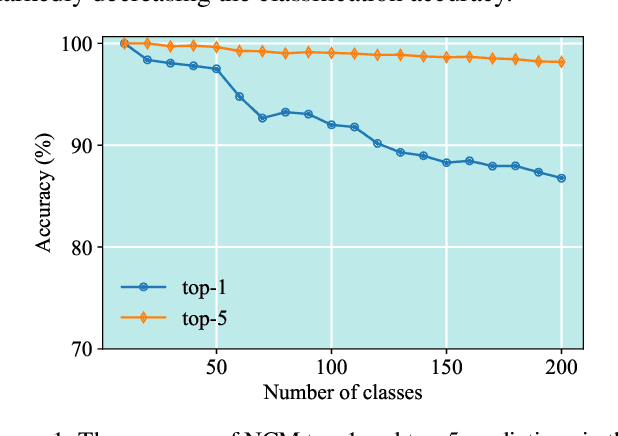
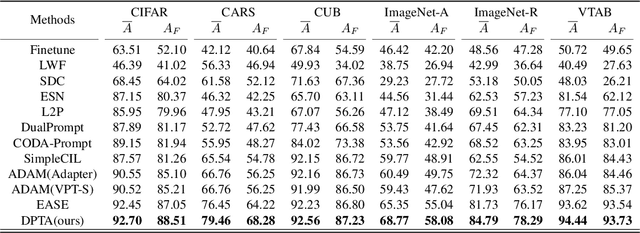
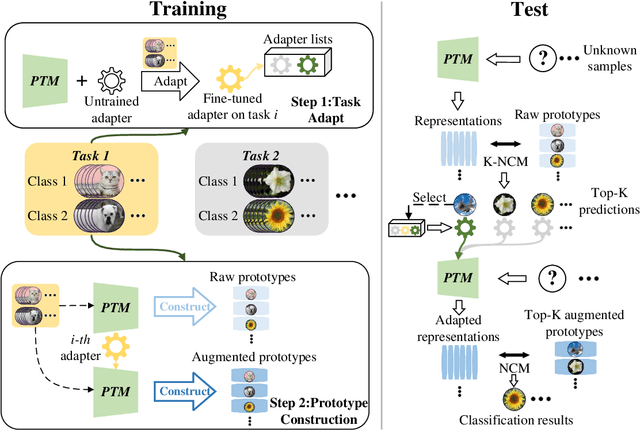
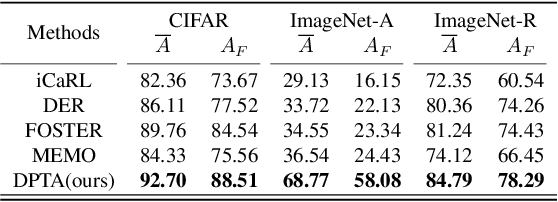
Abstract:Class-incremental learning (CIL) aims to acquire new classes while conserving historical knowledge incrementally. Despite existing pre-trained model (PTM) based methods performing excellently in CIL, it is better to fine-tune them on downstream incremental tasks with massive patterns unknown to PTMs. However, using task streams for fine-tuning could lead to catastrophic forgetting that will erase the knowledge in PTMs. This paper proposes the Dual Prototype network for Task-wise Adaption (DPTA) of PTM-based CIL. For each incremental learning task, a task-wise adapter module is built to fine-tune the PTM, where the center-adapt loss forces the representation to be more centrally clustered and class separable. The dual prototype network improves the prediction process by enabling test-time adapter selection, where the raw prototypes deduce several possible task indexes of test samples to select suitable adapter modules for PTM, and the augmented prototypes that could separate highly correlated classes are utilized to determine the final result. Experiments on several benchmark datasets demonstrate the state-of-the-art performance of DPTA. The code will be open-sourced after the paper is published.
Embedding Space Allocation with Angle-Norm Joint Classifiers for Few-Shot Class-Incremental Learning
Nov 14, 2024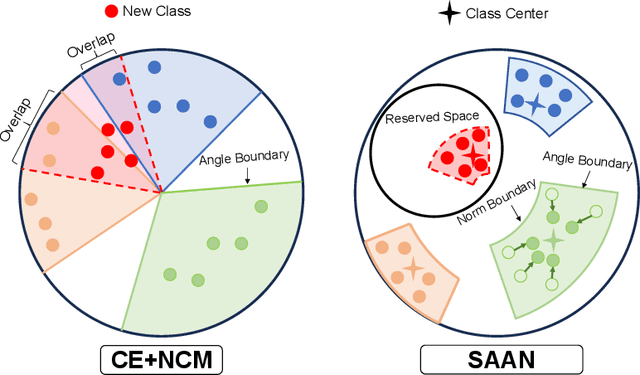
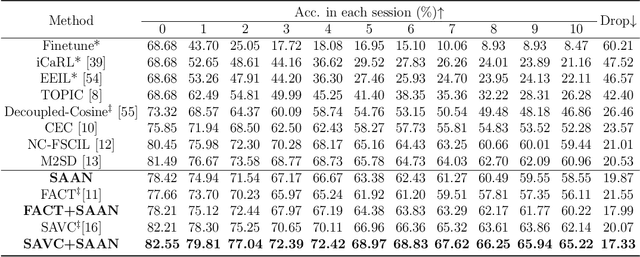
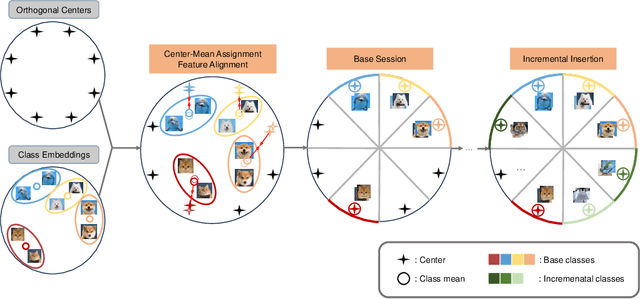
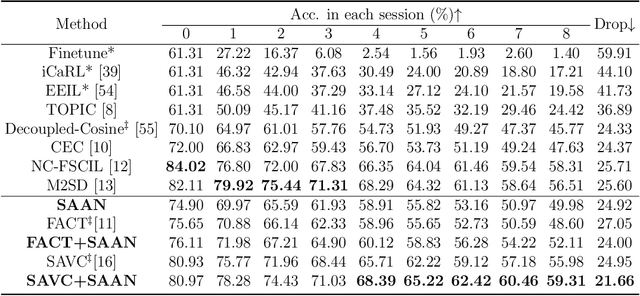
Abstract:Few-shot class-incremental learning (FSCIL) aims to continually learn new classes from only a few samples without forgetting previous ones, requiring intelligent agents to adapt to dynamic environments. FSCIL combines the characteristics and challenges of class-incremental learning and few-shot learning: (i) Current classes occupy the entire feature space, which is detrimental to learning new classes. (ii) The small number of samples in incremental rounds is insufficient for fully training. In existing mainstream virtual class methods, for addressing the challenge (i), they attempt to use virtual classes as placeholders. However, new classes may not necessarily align with the virtual classes. For the challenge (ii), they replace trainable fully connected layers with Nearest Class Mean (NCM) classifiers based on cosine similarity, but NCM classifiers do not account for sample imbalance issues. To address these issues in previous methods, we propose the class-center guided embedding Space Allocation with Angle-Norm joint classifiers (SAAN) learning framework, which provides balanced space for all classes and leverages norm differences caused by sample imbalance to enhance classification criteria. Specifically, for challenge (i), SAAN divides the feature space into multiple subspaces and allocates a dedicated subspace for each session by guiding samples with the pre-set category centers. For challenge (ii), SAAN establishes a norm distribution for each class and generates angle-norm joint logits. Experiments demonstrate that SAAN can achieve state-of-the-art performance and it can be directly embedded into other SOTA methods as a plug-in, further enhancing their performance.
Region-Guided Attack on the Segment Anything Model (SAM)
Nov 05, 2024



Abstract:The Segment Anything Model (SAM) is a cornerstone of image segmentation, demonstrating exceptional performance across various applications, particularly in autonomous driving and medical imaging, where precise segmentation is crucial. However, SAM is vulnerable to adversarial attacks that can significantly impair its functionality through minor input perturbations. Traditional techniques, such as FGSM and PGD, are often ineffective in segmentation tasks due to their reliance on global perturbations that overlook spatial nuances. Recent methods like Attack-SAM-K and UAD have begun to address these challenges, but they frequently depend on external cues and do not fully leverage the structural interdependencies within segmentation processes. This limitation underscores the need for a novel adversarial strategy that exploits the unique characteristics of segmentation tasks. In response, we introduce the Region-Guided Attack (RGA), designed specifically for SAM. RGA utilizes a Region-Guided Map (RGM) to manipulate segmented regions, enabling targeted perturbations that fragment large segments and expand smaller ones, resulting in erroneous outputs from SAM. Our experiments demonstrate that RGA achieves high success rates in both white-box and black-box scenarios, emphasizing the need for robust defenses against such sophisticated attacks. RGA not only reveals SAM's vulnerabilities but also lays the groundwork for developing more resilient defenses against adversarial threats in image segmentation.
 Add to Chrome
Add to Chrome Add to Firefox
Add to Firefox Add to Edge
Add to Edge